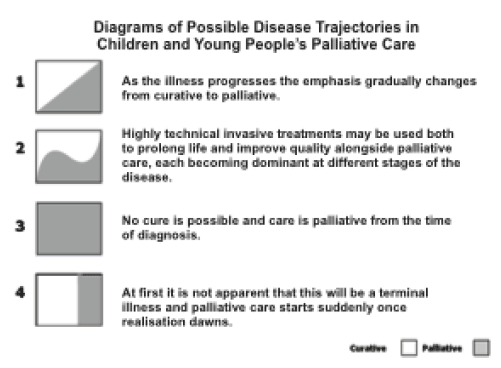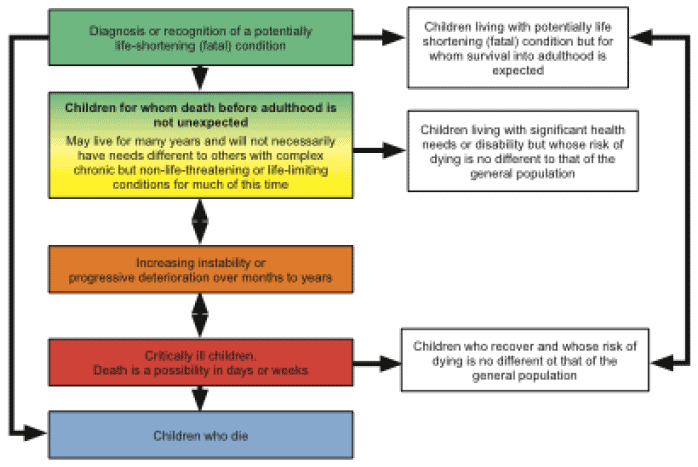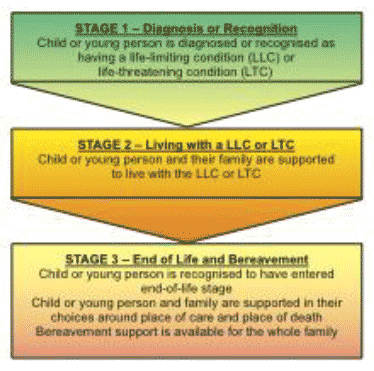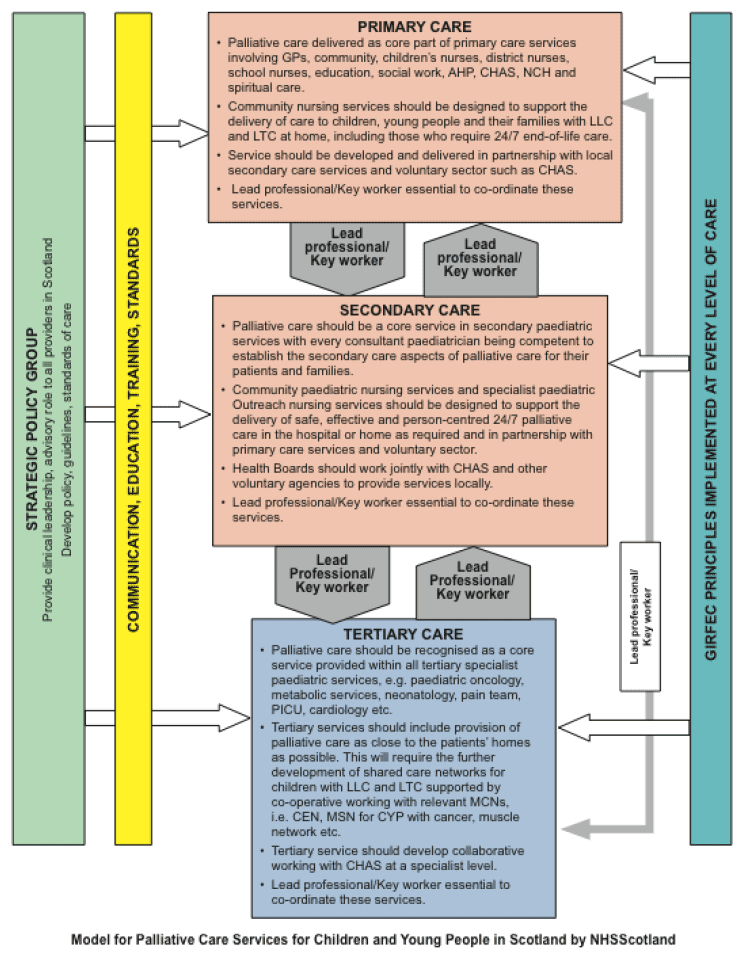A Framework for the Delivery of Palliative Care for Children and Young People in Scotland
The Framework sets out a safe, effective and person centred approach to palliative care for children and young people. It is supported by guidance for services and provides a self assessment tool.
2. The Framework
1. Introduction
This framework aims to ensure that there are recognised pathways for palliative care within and between Health Boards for every child and young person from the point of diagnosis of a life-limiting condition (LLC) or life-threatening condition (LTC), through to living with their illnesses/conditions until the end of their life. These pathways should be equitable, sustainable, age appropriate and independent of geography. Although health services currently provide diagnosis and ongoing management of healthcare needs for children and young people, symptom management and other palliative care needs often become fragmented and sub-optimal in all stages.
Health Boards, in partnership with Social Work, Education, Children's Hospice Association of Scotland (CHAS) and other voluntary organisations should apply the integrated model for palliative care in this framework, taking into consideration the age, geographical and social needs of their particular population of children and young people. The following outcomes and objectives should underpin any palliative care service for children and young people in Scotland, no matter where or how it is provided.
2. Policy context
In 2004, the Scottish Government published the first Getting it Right for Every Child (GIRFEC) guidance1 This recognised that every child and young person should be able to access the services they need to support them living as full a life as possible, however short that life may be.
In 2008, the Scottish Government published Living and Dying Well2 the Government's Action Plan for palliative and end-of-life care for Scotland. This action plan did not actively include or exclude children who have palliative care needs or who require end-of-life care and, subsequently, a group of interested clinicians came together to form the Scottish Children's and Young People's Palliative Care Executive (SCYPPEx) to address the specific palliative care needs of children and young people. SCYPPEx were asked to comment on the recommendations from the Living and Dying Well working group 6, which referred to the needs of young adults and were keen embrace those recommendations for children and young people3.
In January 2011, the Scottish Government published Living and Dying Well: Building on Progress4, which recognised how far services within NHS Boards had progressed since the original report, particularly the work progressed by SCYPPEx to establish an NHSScotland Resuscitation Policy for Children and Young People (C&YP)5. The ongoing role of SCYPPCEx was recognised by the Scottish Government, with an expectation that SCYPPEx would bring together:
"…formal and informal networks concerned with the palliative care of children and young people across Scotland in a single unified voice to provide:
- clinical leadership to influence and develop the delivery of palliative care services to children and young people with all types of long-term and life-limiting illness and their families across Scotland; and
- strategic leadership to influence the wider health, social care and education policy agendas to achieve the best outcomes for children and young people with palliative care needs and their families in Scotland."6
In particular, Action 18 required:
"The Scottish Children's and Young People's Palliative Care Executive (SCYPPEx) should work with NHS Boards, NHS Quality Improvement Scotland, NHS Education for Scotland and the Scottish Partnership for Palliative Care to support a national approach to quality assurance and quality improvement in palliative and end of life care for children and young people."7
3. What is palliative care and what does it involve?
The Royal College of Paediatrics and Child and Health (RCPCH), together with the Association for Children's Palliative Care (ACT), published a definition of paediatric palliative care in 1993. In 2009, ACT further defined children's palliative care as:
"Palliative care for children and young people with life-limiting conditions is an active and total approach to care, from the point of diagnosis or recognition, throughout the child's life, death and beyond. It embraces physical, emotional, social and spiritual elements and focuses on the enhancement of quality of life for the child or young person and support for the family. It includes the management of distressing symptoms, provision of short breaks and care through death and bereavement."8
The requirement for palliative care may be identified at the point of diagnosis or may become apparent as the health of an individual child or young person deteriorates, or the care requirements and symptom control increases. There are different patterns of progression of LLC or LTC towards end of life, as illustrated in Figure 1 below.
Figure 1

Palliative and end-of-life care are integral aspects of the care delivered by any health or social care professional to those living with and, dying from, any advanced, progressive or incurable condition. Palliative care is not just about care in the last months, days and hours of a child or young person's life, but about ensuring quality of life for both the child or young person and their families at every stage of the disease process from diagnosis onwards. A palliative care approach should be used as appropriate alongside active disease management from an early stage in the disease process.
Palliative care focuses on the person, not the disease, and applies a holistic approach to meeting the physical, practical, functional, social, emotional and spiritual needs of the child or young person and their families facing progressive illness and bereavement.
Furthermore, the child or young person can move in and out of palliative care because of successful medical interventions. This is shown diagrammatically in Figure 2, developed by Lynda Brook et al9 which outlines the different stages of palliative care, described as the Rainbow of Palliative Care needs.
Children and young people with LLC and LTC will usually be diagnosed within the appropriate secondary, tertiary and quaternary children's services in Scotland and most will receive much of their ongoing care within these services. This framework recommends that Health Boards hosting all of these services refer to the ACT Integrated Multi-agency Care Pathway for Children with Life Limiting and Life Threatening Illness (2007)10 to ensure they develop local services to enable palliative care to be adequately delivered to these children and young people.
Figure 2

It is widely accepted by professionals working with children and young people that palliative care falls into three stages (Figure 3). This is based on ACT Integrated Multi-agency Care Pathway for Children with Life Limiting and Life Threatening Illness (2009).
Figure 3

4. Developing palliative care services for children and young people
Palliative care services should be planned and delivered to achieve the best outcomes for individual children and young people and their families.
This document has been developed in response to both the policies identified above and the specific requirements of Building on Progress. Whilst recognising that palliative care should be integrated across specialty boundaries and seamless at the point of care delivery, we know that many groups of professionals are already well advanced in the development of care plans for the earlier stages of palliative care, i.e. children with exceptional healthcare needs care pathway11. The palliative care needs of children and young people will vary over time and will depend on the diagnosis or condition that they are living with. A model of care (Figure 4) to describe the approach that should be in place to ensure availability of appropriate palliative care is shown here. The model draws heavily on the work of ACT8,10 and the Paediatric Resuscitation Policy5 and the work of the MCN for Children with Complex Needs (CEN)11 and Children's Hospice Association of Scotland Plan 2011-201612. This model has also been developed to fit the present structure of delivery of healthcare services within the NHS in Scotland.
The majority of palliative care should be provided as close to the patient's home as possible with most of the care being provided within community or primary care settings supported by local secondary care services. These will often include Children's Hospices Association Scotland (CHAS), other voluntary agencies, social work and education partners. The care requirements of children and young people may increase during particular phases of the illness trajectory and these children and young people may require to be cared for by specialists within a tertiary setting or within the local secondary care service during all phases.
This framework recognises that many children and young people who are reaching the end of life phase of their illness will have well-established care plans and be well known to their own primary, secondary and tertiary care services. The aim of this framework is to empower the child or young person's usual healthcare professionals to provide the additional care necessary, following best practice guidelines, to enable effective holistic symptom management and spiritual care as the child or young person progresses through the end of life phase to death, and to provide bereavement support for the family.
Figure 4

5. Outcomes for delivering a palliative care service for children and young people
Health Boards, in partnership with Social Work, Education, Children's Hospice Association of Scotland (CHAS) and other voluntary organisations should apply the integrated model for palliative care in this framework, taking into consideration the age, geographical and social needs of their particular population of children and young people. The following outcomes and objectives should underpin any palliative care service for children and young people in Scotland, no matter where or how it is provided.
Outcome 1
Each Health Board should clearly identify lead professionals with overall responsibility for delivering children and young people's palliative care services.
Outcome 2
Children and young people's palliative care services should be planned and developed on the basis of incidence and prevalence in each Health Board area.
Outcome 3
All children and young people should have equitable access to palliative care which is planned, flexible and person-centred and takes account of their physical, emotional and spiritual needs.
Outcome 4
All children and young people with palliative care needs should be cared for and die in their preferred place.
Outcome 5
All children and young people with palliative care needs will receive safe, effective and person-centred care delivered efficiently and on time by a trained and competent workforce adopting a GIRFEC (Getting it Right for Every Child) approach.
These outcomes meet the recommendations from Living and Dying Well - Building on Progress and the Healthcare Quality Strategy for NHSScotland13. The following key objectives will ensure that these outcomes are achieved.
6. Key objectives for achieving outcomes
Listed below are key objectives that require to be achieved in order to meet the five outcomes described above.
Key objectives:
1. Lead doctor and nurse for children and young persons' palliative care
Every Health Board should ensure that there is an identified lead doctor and nurse within their children's services for palliative care. These could be identified on a regional basis.
2. Identification of all children and young people with palliative care needs
All children and young people with palliative care needs should be identified as this will allow children's services in each Health Board to plan appropriate services and to analyse the gaps between the total resources required against those already committed to palliative care.
3. Breaking bad news
Every family should receive the news of their child's diagnosis or deteriorating condition in a face-to-face discussion in privacy and should be treated with respect, honesty and sensitivity.
4. Lead paediatric consultant
Every child and young person should have an identified lead paediatric consultant who will have overall clinical responsibility for ensuring that care is co-ordinated in a holistic manner.
5. Assessment of care needs and multi-agency care plan
Every child and young person should receive a multi-agency assessment of their palliative care needs and have an anticipatory care plan agreed with them that identifies a lead professional/key worker for the family and provides co-ordinated care and support to meet these needs.
6. Planning discharge
Every child and young person diagnosed with palliative care needs in the hospital setting should have an agreed discharge plan. This plan should include tertiary and secondary hospital services, hospice services, community services and other voluntary services as required.
7. Recognition and planning for end-of-life care
Every child, young person and family should be supported to agree an end of life plan when the end of life stage is recognised. This should include choice of place of care, place of death and completion of an advanced care plan and CYPADM (Child and Young People's Acute Deterioration Management) form.
8. Care after death
Following the death of a child or young person every family should be allowed time and privacy with their child. Bereavement support should be offered for as long as the family requires this and should be appropriate for all family members.
9. Transition
Health Boards should develop local pathways for transition of young people with palliative care needs to appropriate adult services.
10. Education and Training
All staff caring for children, and young people and their families with palliative care needs, should be able to access education and training in order to achieve and maintain the requisite skills, knowledge and competencies to meet the specific palliative care needs of each child or young person.
7. Summary
Implementation of these outcomes and key objectives across all Health Boards will deliver palliative care services which are person-centred, safe, effective, efficient and equitable throughout Scotland for children, young people and their families available where and when they need them.
Health Boards will require to put in place processes in order to achieve these outcomes and key objectives. Palliative care and death is thankfully rare in children and young people, therefore there will be small numbers of children and young people in each Health Board area who require palliative care. The next section of this document offers guidance to Health Boards and other service providers to enable them to meet these outcomes and objectives. This includes reference to pathways, tools, policies and training programmes already available.
8. Assessment and evaluation
Health Boards should assess their children and young people's palliative care services in relation the outcomes and key objectives above. Section 4 of this document provides an easy-to-use self-assessment tool for this purpose. Health Improvement Scotland is also developing quality indicators for delivery of palliative care including that for children and young people14, which will provide further guidance and tools by which Health Boards can measure their services.
9. Organ Donation
There may be an opportunity for children with a life-limiting or life-threatening condition and their families to consider organ or tissue donation. In trying to come to terms with the loss of their own child, many families may derive comfort from the fact that other people have had their lives saved or transformed through donation.
It is essential that conversations about organ donation are had during the life of the child as this allows the child and families to consider the possibilities for organ donation in light of their illness.
In all cases where organ or tissue donation is chosen, there must be a defined cause of death and all processes must adhere to the Human Tissue (Scotland) Act 2006 - A guide to its implications for NHSScotland15. This Act states that where a child dies before the age of 12, only their parent or guardian is entitled to give permission for their organs or tissue to be donated. Children over 12 can give permission themselves. Where they have not done so, their parents or guardians can authorise donation.
Contact
Email: Fiona McKinlay
There is a problem
Thanks for your feedback